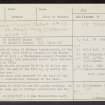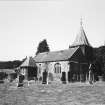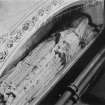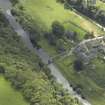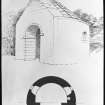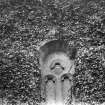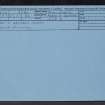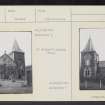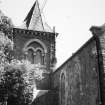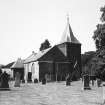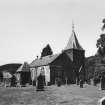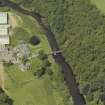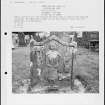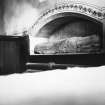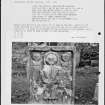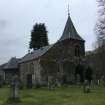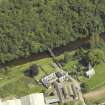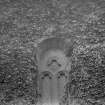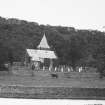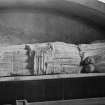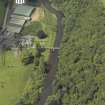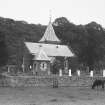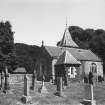Following the launch of trove.scot in February 2025 we are now planning the retiral of some of our webservices. Canmore will be switched off on 24th June 2025. Information about the closure can be found on the HES website: Retiral of HES web services | Historic Environment Scotland
Abbey St Bathans Church
Church (14th Century), Nunnery (12th Century), War Memorial (20th Century)
Site Name Abbey St Bathans Church
Classification Church (14th Century), Nunnery (12th Century), War Memorial (20th Century)
Alternative Name(s) Abbey St Bathan's Kirk, St Bathan's Church, St Bathan's Convent: War Memorial Plaque
Canmore ID 58780
Site Number NT76SE 9
NGR NT 75855 62277
NGR Description Centre
Datum OSGB36 - NGR
Permalink http://canmore.org.uk/site/58780
- Council Scottish Borders, The
- Parish Abbey St Bathans
- Former Region Borders
- Former District Berwickshire
- Former County Berwickshire
NT76SE 9.00 75852 62281
NT76SE 9.01 75863 62266 Churchyard
(NT 75852 62281) St Bathan's Church (NAT).
(NT 7586 6233) St Bathan's Convent (NR) (Site of).
OS 6" map, Berwickshire, 2nd ed.,(1908).
The parish church of Abbey St Bathans incorporates, in the east and north walls, late 14th century remains of the Church of the Priory of St Mary - a Cistercian nunnery founded in the late 12th or early 13th centuries (exact date unknown) and secularised in 1622.
The Priory church measured 58ft by 26ft but was contracted, about the end of the 18th century, by moving the west wall further east. Foundations have been observed to the east of the church and for a considerable distance to the west.
RCAHMS 1915; D E Easson 1957; New Statistical Account (NSA, J Wallace 1834), 1845.
St Bathan's Church is still in use for public worship: no foundations were seen and no further information was obtained locally.
Visited by OS(EGC) 9 May 1966.
EXTERNAL REFERENCE
The National Library of Scotland contains among the 'Uncatelogued MSS of General Hutton and numbered 32 in Vol 11 a sketch of what is called St Bathan's Nunnery, the SE view and dated 1788. The ruins of the old church are situated on the Whiteadder Water about 6 miles nearly due S of Cockburnspath. It is said that no relics remain of the Priory for Cistercian Nuns founded at Abbey St Bathams in the XII century.
Field Visit (5 August 1908)
1. Abbey St Bathans Church.
The parish church of Abbey St Bathans is situated on the right bank of the Whitadder, about 4 miles south-west of Grant's House on the site of the ancient Church of the Priory of St Bothan (Cistercian), of which the east wall and the lower portions of the north wall are the only remains. The east wall, 24 feet wide by 4 feet thick, is pierced by a round-headed late 14th-century window of two trefoil-headed lights surmounted by a quatrefoil. Near the west end of the north wall are traces of a blocked-up doorway with a semicircular head. Foundations have been observed to the east of the present church, and also for a considerable distance to the west.
The last Prioress was Elizabeth Lamb, who, with consent of three nuns, conveyed in 1558 to John Renton of Billie the lands of Nunmeadow, Nunbutts, and Nunflat (1).
Recumbent effigy. In a low-arched recess of recent date in the east wall lies the effigy of a nun, apparently a prioress of this or another of the Cistercian nunneries, of which there were several in this part of Scotland. The figure, which is 6 feet long, is dressed in a full tunic or kirtle falling in heavy folds over the feet, but with close sleeves. The hands, which are mutilated, are joined in prayer, and a plain narrow girdle is just visible between. the wrists. The neck is covered by a barbe or wimple, the lower edge of which is straight, the upper parts showing folds following the line of the chin. A plain cope-like mantle covers the shoulders and sides of the figure, extending with long vertical folds to the feet; it is not joined or fastened at the neck. Two veils cover the head and fall infolds on the shoulders, and the under veil, presumably representing linen, shows a crimped edge alongside the plain edge of the outer veil. There are the remains of a crosier lying within the right arm, the head of the crosier being close to the head of the figure and the point resting on a small animal which lies outstretched across the ankles. The feet of the figure are hidden by the folds of the habit, and the head rests on two cushions with short tassels at the corners. The crosier is much broken, but there are indications that the head was crocketed. The middle of the effigy has had a miniature supporting angel at each side; of these the one on the right is almost entirely broken away, but enough remains of the other to show a girded alb, raised arms, and outstretched wings, indicating that the angels were represented as rising up from beneath the effigy and supporting it with their backs, wings, and arms. There are no traces of supporters at the head or feet.
That the crosier was not confined to abbots, but was also used by priors, is shown by such cases as that of the prior of Taunton, Somerset, who received a papal grant of pontifical insignia, except the mitre, in 1499 (2). The priors of Christ Church, Canterbury, and Durham used the crosier from 1374 and 1378 respectively. It may be gathered from this effigy that some Cistercian prioresses also used it. The date of the effigy is perhaps the last half of the fifteenth century or the beginning of the sixteenth.
RCAHMS 1915, visited 5 August 1908.
See Eccles. Arch., iii. p. 410 (illus.); Ber. Nat. Club, 1890-91, p. 92; (1) Wedderburn Papers (Hist. MSS. Com.), p. 272; (2) Printed by Tanner, Notitia Monastica, Cambridge, 1787, p. xvi. n.
Publication Account (1985)
The ubiquitous dark green paintwork on the interesting range of vernacular house types confirms that Abbey St Bathan's is very much an estate village, built just above a ford on the Whiteadder Water. It is also the site of the ancient Cistercian monastery ofSt Botha founded in the later 12th century by Ada, countess of Dun bar. The last prioress, Elizabeth Lamb, disposed of the lands of Nunmeadow, Nunbutts and Nunflat to John Renton of Billie in 1558. Inside the church lies the effigy of a nun, apparently a prioress dressed in a full tunic, her hands joined in prayer and two veils over her head. There are also the remains of a crozier within her right arm-a rare example that confirms not only that priors used the crozier in addition to abbots, but some Cistercian prioresses too. The effigy is probably late 15th-early 16th century.
As to the church itsel, most is late 18th century; only the east wall with its late 14th century round-headed windows, and lower parts of the north wall remain from an earlier period, whilst the later flavour of Reformation and Presbyterianism is reflected in the wall-painted texts flanking the Table and window at the east end.
Just inside the entrance, a remarkably well-preserved early 18th century gravestone reflects well not just upon a contemporary minister, George Home, died 1705, but on the concern of his wife, Jean Hamilton, for the endowment after her death in 1719 of a school at Abbey St Bathan's.
Information from 'Exploring Scotland's Heritage: Lothian and Borders', (1985).
Note (23 July 2015)
Within the church there is a bronze plaque set in a marble mount with four names inscribed who fell in the First World War.
The iscription reads 'To the glorious memory of those of this Parish who fell in the Great War 1914-1919. Their Name liveth for evermore'
Second Lieutenant James Lawson, Private Ralph Dodds, Private William Yule, Private James Yule.
Information from RCAHMS (AKK) 23 July 2015
Note (27 September 2019)
The location, classification and period of this site have been reviewed.
Sbc Note
Visibility: Upstanding building, which may not be intact.
Information from Scottish Borders Council






























